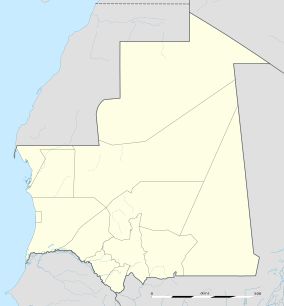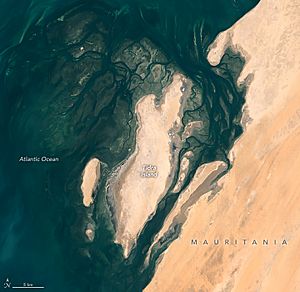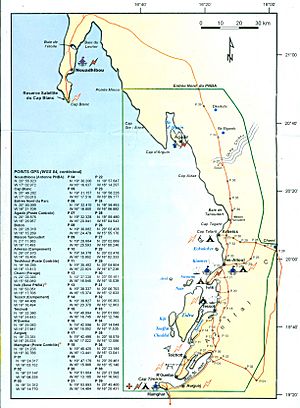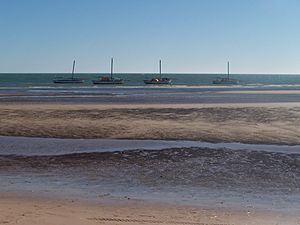Banc d'Arguin National Park facts for kids
Quick facts for kids Banc d'Arguin National Parkحوض أركين |
|
|---|---|
|
IUCN Category II (National Park)
|
|
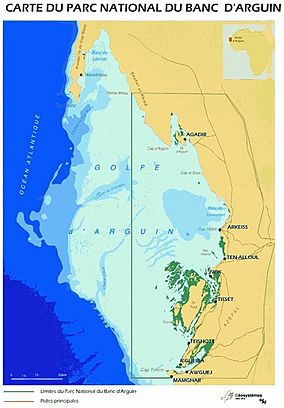
Map of the bay showing the Banc d'Arguin National Park
|
|
| Location | Mauritania |
| Nearest city | Nouakchott and Nouadhibou |
| Area | 12,000 km2 (4,600 sq mi) |
| Established | 1976 |
| Governing body | IUCN |
| Type: | Natural |
| Criteria: | ix, x |
| Designated: | 1989 (13th session) |
| Reference #: | 506 |
| Region: | Arab States |
| Official name: Parc National du Banc d'Arguin | |
| Designated: | 22 October 1982 |
| Reference #: | 250 |
The Banc d'Arguin National Park is a special nature reserve in Mauritania, a country in Western Africa. It's located on the west coast, between the cities of Nouakchott and Nouadhibou. This park is a World Heritage Site, which means it's recognized globally for its importance.
The park is famous for its huge numbers of migratory and breeding birds. You can see many different species here, like flamingos, pelicans, and terns. Many birds build their nests on the park's sand banks and islands, including Tidra, Niroumi, Nair, Kijji, and Arguim. The waters around the park are also very rich in fish, making them important nesting areas for marine life in West Africa.
The Banc d'Arguin National Park was created in 1976. Its main goal is to protect the amazing natural environment and the important fishing areas. These fisheries help the country's economy a lot. The park also protects unique geological sites that are valuable for science and simply beautiful to see.
The park has huge areas of mudflats. These muddy areas are home to over a million shorebirds that migrate from places like northern Europe, Siberia, and Greenland. The weather here is mild, and there isn't much human activity, which makes the park a perfect safe haven for these birds. The number and variety of nesting birds are also impressive. Between 25,000 and 40,000 pairs of 15 different bird species make their homes here, forming the largest water bird colonies in West Africa.
Contents
Protecting Banc d'Arguin National Park
The park's wide intertidal zones (areas covered by water at high tide and exposed at low tide) protect some of the most untouched seagrass beds on Earth. Humans have had very little impact here compared to other similar areas along the East Atlantic Flyway, which is a major bird migration route.
Only a small group of local people, called the Imraguen, are allowed to fish within the park. They use traditional fishing methods and tools. Motorized boats are not allowed in the area to keep it peaceful and protected. However, in recent years, the international market for sharks and rays has reached the park. Some locals have started to fish for these species, even though it's not allowed. This is one of the biggest challenges for the park's conservation efforts.
The Imraguen People
About 500 Imraguen tribesmen live in seven villages inside the park. Their way of life depends on fishing for their own food, using traditional methods passed down through generations. They live in harmony with the park's environment.
Amazing Animals of the Park
The Banc d'Arguin National Park is home to one of the world's most diverse groups of nesting fish-eating birds. More than 108 bird species have been seen here, including birds from both Europe/Asia and Africa.
Wintering Birds
Over three million shorebirds spend their winters here. Some of these include:
- Greater flamingo (Phoenicopterus roseus)
- Ringed plover (Charadrius hiaticula)
- Grey plover (Pluvialis squatarola)
- Red knot (Calidris canutus)
- Common redshank (Tringa totatus)
- Bar-tailed godwit (Limosa lapponica)
This area is also a very important winter home for the Eurasian spoonbill (Platalea leucorodia leucorodia).
Breeding Birds
Birds that breed in the park include:
- White pelican (Pelecanus onocrotalus)
- Reed cormorant (Phalacrocorax africanus)
- Gull-billed tern (Gelochelidon nilotica)
- Caspian tern (Hydroprogne caspia)
- Royal tern (Sterna maxima)
- Common tern (Sterna hirundo)
You can also find African species like the grey heron (Ardea cinerea monicae) and the western reef heron (Egretta gularis).
Marine Mammals
Many endangered marine mammals can be seen here all year round. These include:
- Mediterranean monk seals
- Atlantic humpback dolphins
- Bottlenose dolphins
Other amazing marine animals that visit the park are killer whales (orcas), pilot whales, Risso's dolphins, and other types of dolphins like the common dolphin and rough-toothed dolphin. Even larger whales like fin whales and harbor porpoises are known to visit. It's possible that very rare whales like the North Atlantic right whale and even the now-extinct Atlantic gray whale used to be seen here. Other large whales like humpbacks, seis, blues, Brydes's, and minkes have also been spotted in nearby waters.
The waters of Banc d'Arguin are also full of fish, and a very rare type of shark, the false shark ray, is only found in this region.
Plants of the Coast
The coastline of Banc d'Arguin is shaped by strong waves and constantly moving sand banks. The Ras Nouadhibou peninsula, which forms Dakhlet Nouadhibou bay, is about fifty kilometers long. This peninsula is split between Morocco and Mauritania.
Plants are rare on the coastal sand dunes. However, at the base of the sand ridges, you can find large tamarisk bushes, small acacia trees, and swallowworts. In the central part of the park, some tall grass grows mixed with balsam, spurge, and spiny shrubs. The northern part of the park has very little plant life.
Park Climate
The coastal area of Mauritania, where the park is located, stretches along the Atlantic coast for about 754 kilometers. Winds from the Canary Islands make the climate humid and mild, even though it's close to the desert.
There isn't much rainfall here. In Nouadhibou, for example, it rains less than three centimeters a year, mostly between July and September. Temperatures are moderate. The average high temperatures are around 28°C in Nouadhibou and 32°C in Nouakchott. The average low temperatures are about 16°C and 19°C, respectively.
A Glimpse into History
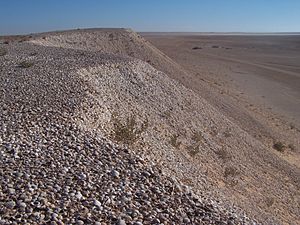
Because of its rich fishing grounds and important location, the Banc d'Arguin area was highly desired and fought over by European colonial powers like Portugal, France, England, and Holland.
- From 1445 to 1633, the Portuguese controlled the area.
- Then, the Dutch took over from 1633 to 1678.
- After a short French occupation, the area was abandoned.
- From 1685 to 1721, it was ruled by Brandenburg (later Prussia).
- Then, there were periods of French and Dutch rule until 1728.
One famous event in the park's history is the wreck of the La Méduse. This French ship ran aground near Banc d'Arguin on July 2, 1816. The story of the survivors inspired a famous painting in 1819 by Théodore Géricault called "The Raft of the Medusa", which you can see in the Louvre Museum in Paris, France.
In the 15th century, the Portuguese set up a trading fort at Arguin in 1455. They were hoping to find gold but soon started trading in slaves. Later, the Dutch took over and began trading in gum arabic, a valuable product from acacia trees used in printing textiles. By 1678, the French had taken control.
The local people, known as the Moors, learned to play the European powers against each other to their own benefit. They would demand gifts and annual payments from the European companies for doing business. Eventually, France gained control of the West African coast from Cap Blanc south to Senegal after the Congress of Vienna in 1815.
See also
 In Spanish: Parque nacional del Banco de Arguin para niños
In Spanish: Parque nacional del Banco de Arguin para niños
- Arguin Island


